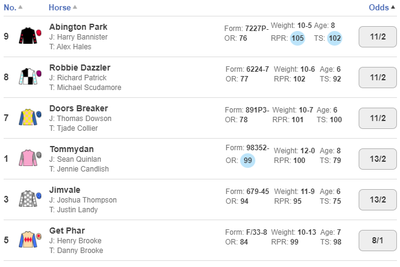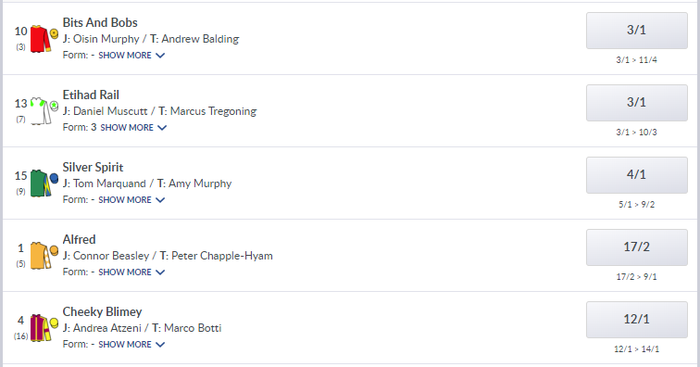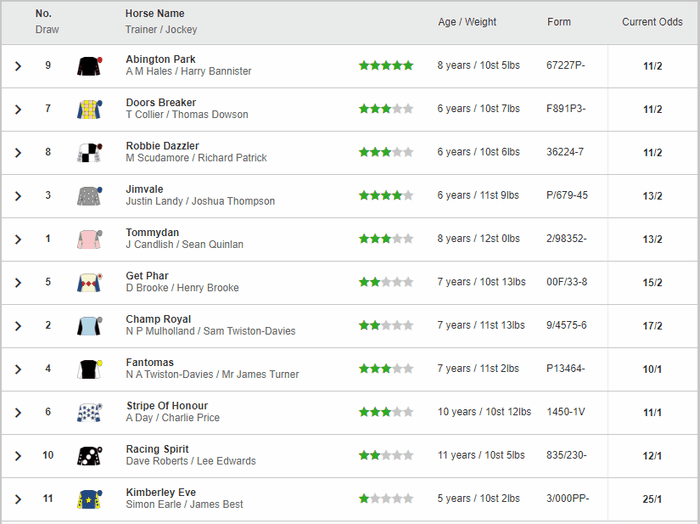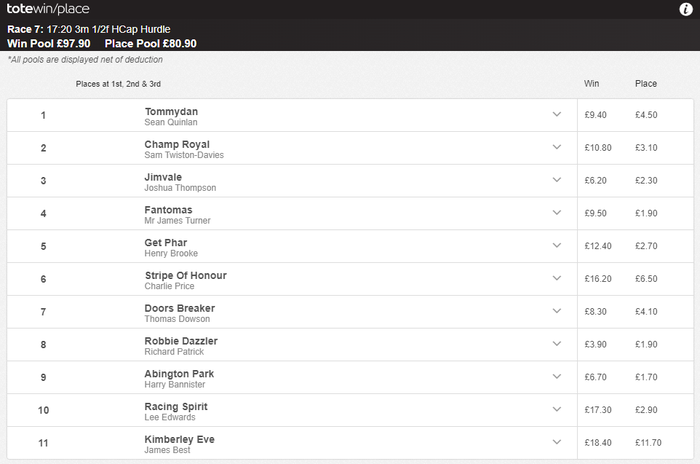 Even those with only a passing interest in horse racing will likely be familiar with the term “Favourite”. Variously referred to as the “jolly” or “market leader”, the favourite in any given race is simply the horse with the shortest odds and therefore – at least in theory – the strongest chance of winning.
Even those with only a passing interest in horse racing will likely be familiar with the term “Favourite”. Variously referred to as the “jolly” or “market leader”, the favourite in any given race is simply the horse with the shortest odds and therefore – at least in theory – the strongest chance of winning.
When assessing the odds ahead of any race, the favourite can be found at the head of the list of runners. Following the conclusion of a race, the horse which started the contest with the lowest odds will be identified by a handy “F” alongside its odds e.g., Sprinter Sacre 11/8F.
In the majority of races, the wisdom of the bookmakers and legions of punters successfully combines to identify a single favourite, but that’s not always the case. There are, in fact, many occasions when not one, but two, three, or more runners cannot be separated at the head of the betting – a situation which leads us into the realm of Joint and Co-Favourites.
Here we look at what this terminology means, the related race card notation and any potential betting implications.
Joint Favourites

The term “Joint Favourite” refers to the situation where two – and ONLY two – runners enjoy equal status at the head of the betting. The notation for this amongst the racing results pages, in newspapers and online, is the rather logical “JF”.
This JF classification extends into the area of second favourites, i.e. the runner with the second shortest odds in the race. A single unique second favourite will be identified using the “2F” notation. If two – and again ONLY two – runners share this position in the betting, the J will be introduced to become “J2F”.
Co-Favourites

Most races have a single outright favourite and those which don’t generally fall into the joint favourite category. However, some races appear so closely matched on paper that the bookmakers can’t settle on one or even two market leaders. Enter the Co-Favourite.
The term “Co-Favourite”, denoted as CF, refers to those occasions when three or more runners share the status of being the shortest-priced horses for a race. This does not happen too often but equally is not so uncommon as to be especially remarkable.
When looking over the results, you may notice that a number often follows the “CF” notation, e.g. CF3, CF4, or even CF5. This simply refers to the number of horses who share the status of favourite: CF3 reading as co-favourite of 3, CF4 as co-favourite of 4 and so on.
In common with favourites and joint favourites, the term co-favourite also extends to second favourites – co-second favourites being denoted as C2F. Again, any numbers following the “F”, represent the number of runners sharing the status as co-second favourite, e.g. C2F4 reads as co-second favourite of 4. In such an example four horses all have the second-shortest odds in the field.
Favourites Notation: Quick Guide
| Notation | Definition |
|---|---|
| F | Favourite |
| 2F | Second Favourite |
| JF | Joint Favourite |
| J2F | Joint Second Favourite |
| CF | Co-Favourite |
| C2F | Co Second Favourite |
| CF3 | Co-Favourite of 3 |
| CF4 | Co-Favourite of 4 |
| C2F3 | Co-Second Favourite of 3 |
| C2F4 | Co-Second Favourite of 4 |
Example Races
Having outlined what the terms Joint Favourite, Co-Favourite and Co-Second Favourite mean, let’s take a look at a few example races to see the terminology in action.
Joint Favourites
| Horse | Odds |
|---|---|
| Westover | 2/1JF |
| Emily Upjohn | 2/1JF |
| Point Lonsdale | 7/2 |
| Hurricane Lane | 4/1 |
| Tunnes | 16/1 |
In this example, Westover and Emily Upjohn are the joint shortest-priced runners in the market and are therefore classified as joint favourites. Note that in any race with joint favourites, you will never see a second favourite identified, as both the first and second favourites are considered to be contained within the two joint favourites.
Co-Favourites
| Horse | Odds |
|---|---|
| Marhaba The Champ | 5/1CF3 |
| Honiton | 5/1CF3 |
| Caius Chorister | 5/1CF3 |
| Savvy Victory | 15/2 |
| Max Mayem | 8/1 |
| Masekela | 9/1 |
In this example, Marhaba The Champ, Honiton, and Caius Chorister are all priced at 5/1 at the head of the betting and are therefore each classified as a co-favourite of 3. As in the case of joint favourites, we have no second favourite classification here, with each of the co-favourites effectively being the shared 1st, 2nd, and 3rd favourite for the race.
Co-Second Favourites
| Horse | Odds |
|---|---|
| All The Kings Men | 4/1F |
| Revich | 11/2 C2F4 |
| Blue For You | 11/2 C2F4 |
| Rhoscolyn | 11/2 C2F4 |
| Fantastic Fox | 11/2 C2F4 |
| Dual Identity | 8/1 |
All The Kings Men is out on his own at 4/1 and is, therefore, the sole favourite for the race. Things are tight behind him, with Revich, Blue For You, Rhoscolyn, and Fantastic Fox all priced at 11/2, and, therefore, classified as co-second favourites of 4.
What are the Betting Implications of Joint and Co-Favourites?

When placing a bet, most punters select the name or number of the horse they wish to back – whether via a click online or writing it out on a betting slip in the real world. If betting in this way, i.e. by identifying a specific horse, your returns will be the same whether your selection is the outright favourite, joint-Favourite, or even co-second favourite of eight.
However, rather than naming a particular horse, some bettors state that they wish to back the favourite or second favourite for a race – whichever horse this ultimately ends up being. Referred to as backing the “Unnamed Favourite” or “Unnamed Second Favourite”, this option can typically be found below the list of runners and odds at most online betting sites.
The settlement of these Unnamed Favourite-style bets is a straightforward process if a race returns only a single market leader, or second favourite. The process can become a little more confusing if joint or co-favourites are involved, but thankfully all bookmakers follow the same process for deciding how your wager will function.
Joint Favourite Bet Settlement
In the instance where a race returns joint favourites, any punters who have placed a bet on the “Unnamed Favourite”, will have their total stake split in two. Half of the total stake is then placed on each of the two joint favourites.
Punters backing the “Unnamed Second Favourite” will also have their stake split between the joint favourites. This is due to the fact that a joint favourite is classed as being an outright favourite and a second favourite rolled into one. Essentially both horses share the status of favourite and second favourite.
Co-Favourite Bet Settlement
In the case of co-favourites, the same rationale is followed. A race featuring three co-favourites would see “Unnamed Favourite” and “Unnamed Second Favourite” stakes split in three and shared between the three runners; co-favourites of 4 would see 1/4 of the total stake placed on each runner, and so on.
In an example with one clear favourite and a number of co-second favourites – such as the All The Kings Men race detailed above – “Unnamed Second Favourite” backers would have their stake divided equally amongst the number of Co-Second Favourites.
No Win Potential – No Bet

In theory, the stake-splitting method outlined above could occasionally see a punter receive less than their initial stake, even if their bet “wins”.
For example, consider a race featuring joint favourites priced at 10/11 and a punter who placed a £2 bet on the unnamed favourite option. With the stake split between the two runners, the most the punter could expect to receive back would be £1.91 (£1 at 10/11 returns £1.91) should either of the joint-favourites win. If both lost, the punter, of course, would lose their £2 stake. This situation, in which the best-case scenario still represents a loss for the punter, seems slightly unfair.
Happily, the majority of bookmakers are also of this opinion. If joint or co-favourites return a price which makes it impossible for an unnamed favourite backer to secure a positive outcome – regardless of the result – the “Unnamed Favourite” market will be deemed a non-runner and all stakes returned.
Things Are A Little Different On The Tote

Be aware that all of the above applies to traditional, fixed odds wagers only. Anyone placing a bet on the Tote will find different rules in place.
Unnamed favourite betting is not accepted on standard Tote Win bets but it is allowed on many other popular options, including the Placepot, Jackpot, and Quadpot. Unnamed second favourite betting is not an option on any Tote product.
Unlike traditional bookmakers, the Tote does not split stakes in the event of joint favourites or co-favourites, but instead places the whole stake on the joint or co-favourite which has the lowest racecard number.
For example, consider a race where Horse Number 1. Arlo’s Answer, and Horse Number 7. Natalie’s Nightmare start as joint favourites. In this instance, any “Unnamed Favourite” backers would have their whole stake placed on Arlo’s Answer due to the lower racecard number. This can be frustrating should the “other” joint favourite win but, on the plus side, the returns are greater if you end up having your whole stake on the winner rather than split between a number of runners.
